
RDL-3000
INSTALLATION GUIDELINES
70-00159-01-06
Proprietary Redline Communications © 2012
Page
12
of 65
kune 12, 2012
grounding practices detailed in local and national electrical codes can minimize
equipment damage, service outages, and chance of serious injury.
The major reasons for surge damage can be summarized as:
-
Poorly grounded antenna sites
-
Improperly installed surge protection equipment
A lighting protection system provides a means by which the energy may enter earth
without passing through and causing damage to parts of a structure. A good grounding
system disperses most of the surge energy from a lightning strike away from the building
and equipment. Improperly grounded connections are a source of noise that can cause
malfunctions in sensitive equipment. The remaining energy on the Ethernet cable shield
and conductors can be directed safely to ground by installing a surge arrestor in series
with the cable. A surge protection system does not prevent lightning strikes, but protects
equipment by providing a low resistance path for the discharge of energy safely to
ground. If you have determined that surge protection is required for your system, the
following general industry practices are provided as a guideline only:
1.
The AC wall outlet ground for the indoor POE adapter should be connected to the
building grounding system.
2.
Install a surge arrestor in series with the Ethernet cable at the point of entry to the
building. The grounding wire should be connected to the same termination point
used for the tower or mast.
3.
Provide direct grounding connections from the RDL-3000, the mounting bracket, and
the antenna to the common building ground bus. Use the grounding screws provided
for terminating the ground wires.
L
’installation exige aussi que l’appareil soit branché à un parafoudre qui répond à
toutes les normes nationales de sécurité.
2
Regulatory Notices
FCC Notices: Deployment in USA
The following notices about deployment in the USA are included in training and
documentation provided to professional installers and operators of the final product:
1.
The final product must be professionally installed.
2.
WARNING -- FCC RF Exposure Warnings
To satisfy FCC RF exposure requirements for RF transmitting devices, the following
distances should be maintained between the antenna of this device and persons
during device operation:
Table 3: Notice - Recommended Safe Distances
Frequency (GHz)
Deployment
Separation Distance
4.9 - 5.3
PMP
120 cm (47.25 in) or more
5.8
PMP
20 cm (7.8 in) or more
To ensure compliance, operation at closer than these distances is not
recommended. The antenna used for this transmitter must not be collocated in
conjunction with any other antenna or transmitter.
3.
FCC Information to Users @ FCC 15.105:
NOTE: This equipment has been tested and found to comply with the limits for a
Class B digital device, pursuant to part 15 of the FCC Rules. These limits are













































